Detailed SWOT Analysis of Unilever: Business Strategy Report
VerifiedAdded on 2021/02/20
|5
|997
|86
Report
AI Summary
This report presents a SWOT (Strengths, Weaknesses, Opportunities, and Threats) analysis of Unilever, a prominent British-Dutch consumer goods company. The analysis examines Unilever's internal strengths, such as its global presence, extensive product portfolio, and investment in R&D, and its external opportunities, including technological advancements and the rise of health-conscious consumers. The report also identifies weaknesses, like product imitability and reliance on retailers, and threats, such as industrial rivalry and economic uncertainties related to Brexit. The conclusion emphasizes the importance of SWOT analysis for strategic decision-making, helping companies like Unilever leverage their strengths, mitigate weaknesses and threats, and capitalize on opportunities to achieve sustainable growth in the competitive consumer goods market. The report references several academic sources to support its findings.
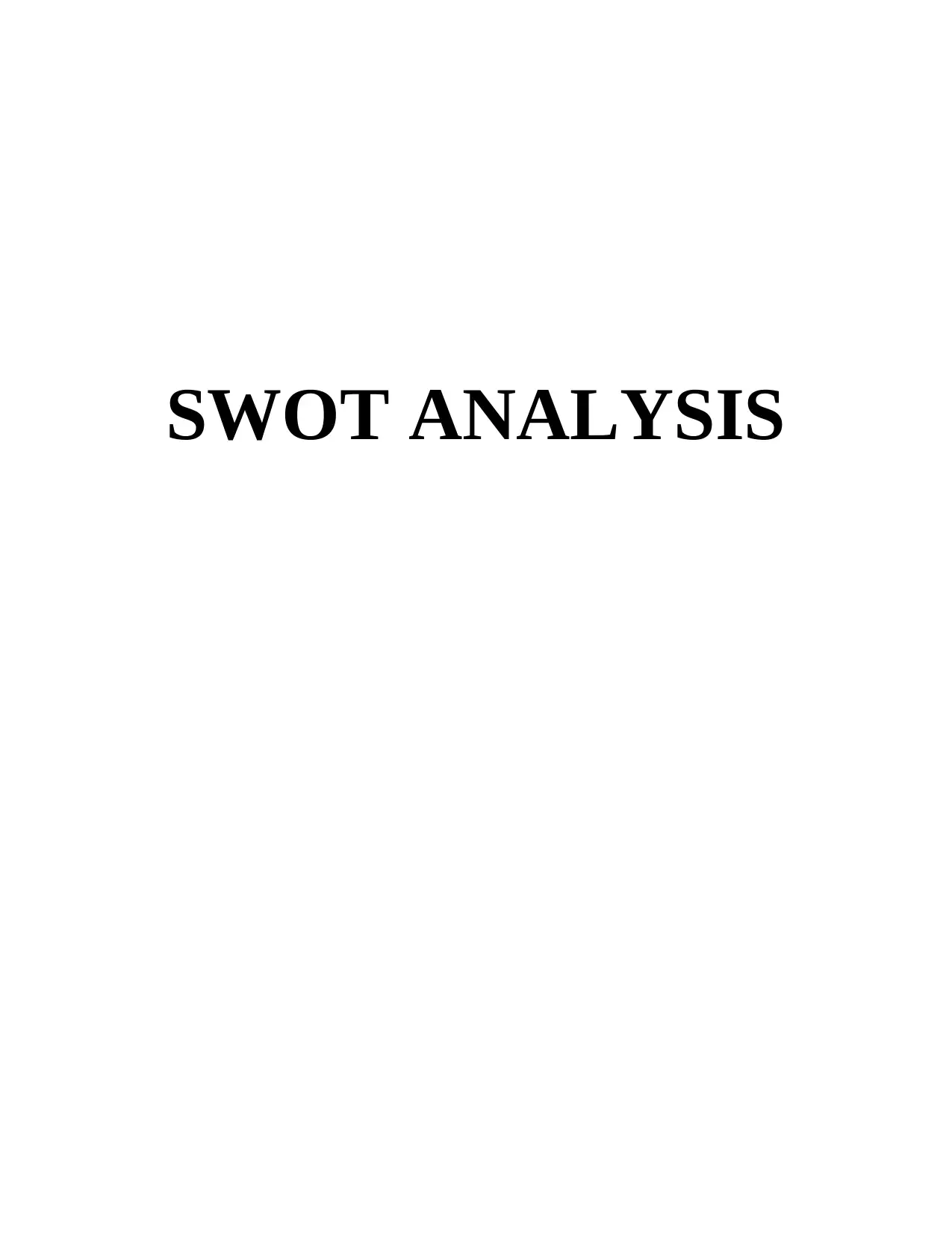
SWOT ANALYSIS
Paraphrase This Document
Need a fresh take? Get an instant paraphrase of this document with our AI Paraphraser
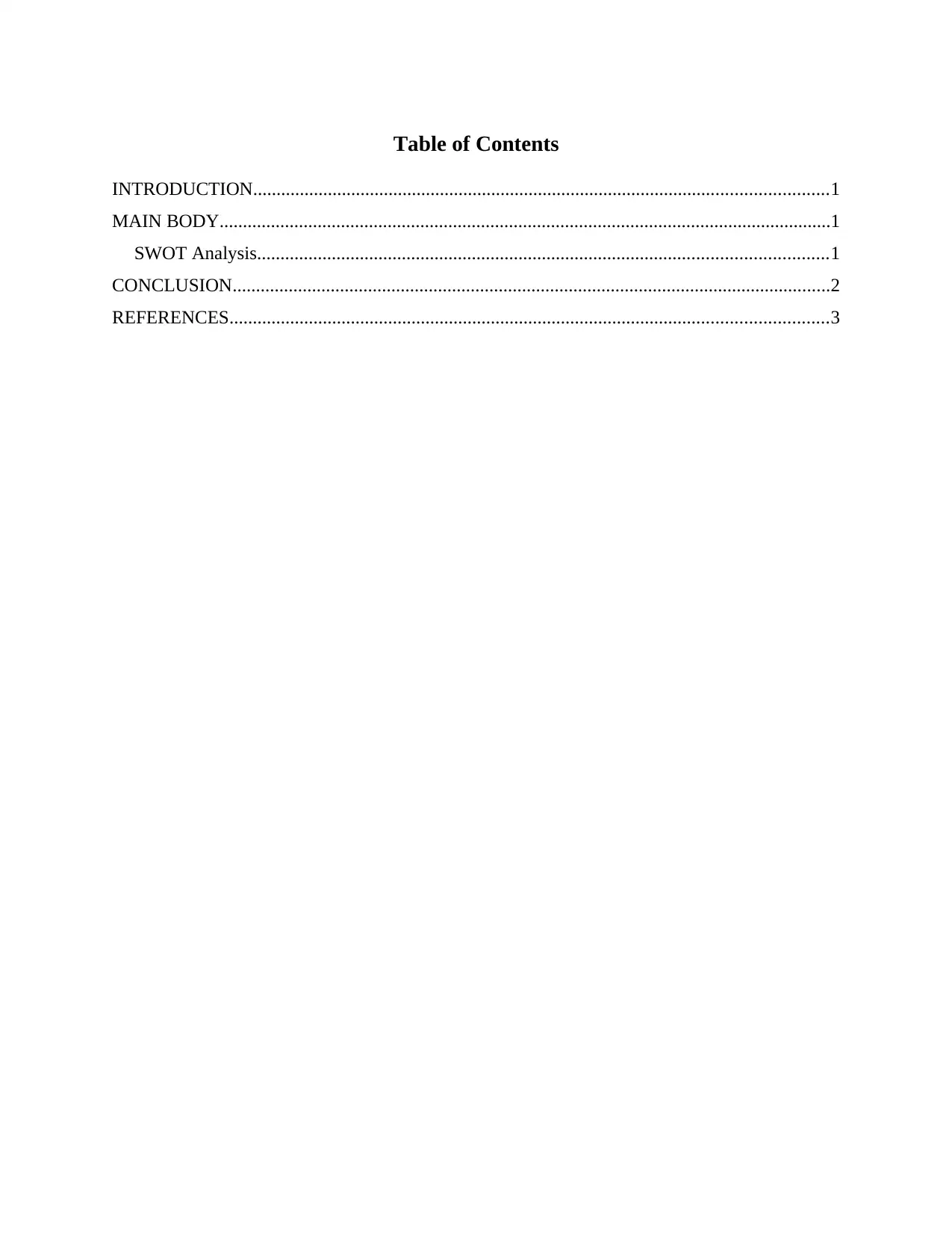
Table of Contents
INTRODUCTION...........................................................................................................................1
MAIN BODY...................................................................................................................................1
SWOT Analysis..........................................................................................................................1
CONCLUSION................................................................................................................................2
REFERENCES................................................................................................................................3
INTRODUCTION...........................................................................................................................1
MAIN BODY...................................................................................................................................1
SWOT Analysis..........................................................................................................................1
CONCLUSION................................................................................................................................2
REFERENCES................................................................................................................................3
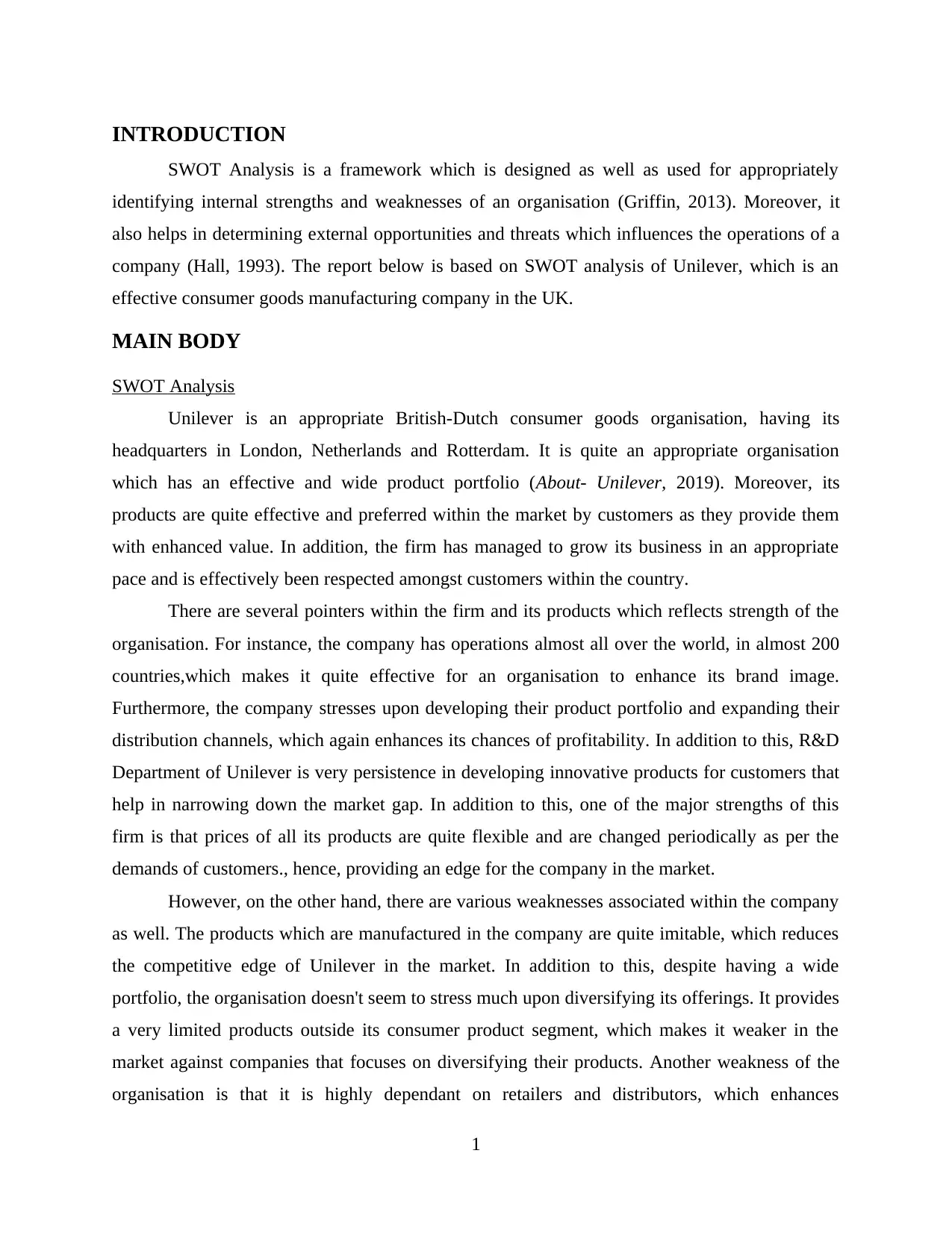
INTRODUCTION
SWOT Analysis is a framework which is designed as well as used for appropriately
identifying internal strengths and weaknesses of an organisation (Griffin, 2013). Moreover, it
also helps in determining external opportunities and threats which influences the operations of a
company (Hall, 1993). The report below is based on SWOT analysis of Unilever, which is an
effective consumer goods manufacturing company in the UK.
MAIN BODY
SWOT Analysis
Unilever is an appropriate British-Dutch consumer goods organisation, having its
headquarters in London, Netherlands and Rotterdam. It is quite an appropriate organisation
which has an effective and wide product portfolio (About- Unilever, 2019). Moreover, its
products are quite effective and preferred within the market by customers as they provide them
with enhanced value. In addition, the firm has managed to grow its business in an appropriate
pace and is effectively been respected amongst customers within the country.
There are several pointers within the firm and its products which reflects strength of the
organisation. For instance, the company has operations almost all over the world, in almost 200
countries,which makes it quite effective for an organisation to enhance its brand image.
Furthermore, the company stresses upon developing their product portfolio and expanding their
distribution channels, which again enhances its chances of profitability. In addition to this, R&D
Department of Unilever is very persistence in developing innovative products for customers that
help in narrowing down the market gap. In addition to this, one of the major strengths of this
firm is that prices of all its products are quite flexible and are changed periodically as per the
demands of customers., hence, providing an edge for the company in the market.
However, on the other hand, there are various weaknesses associated within the company
as well. The products which are manufactured in the company are quite imitable, which reduces
the competitive edge of Unilever in the market. In addition to this, despite having a wide
portfolio, the organisation doesn't seem to stress much upon diversifying its offerings. It provides
a very limited products outside its consumer product segment, which makes it weaker in the
market against companies that focuses on diversifying their products. Another weakness of the
organisation is that it is highly dependant on retailers and distributors, which enhances
1
SWOT Analysis is a framework which is designed as well as used for appropriately
identifying internal strengths and weaknesses of an organisation (Griffin, 2013). Moreover, it
also helps in determining external opportunities and threats which influences the operations of a
company (Hall, 1993). The report below is based on SWOT analysis of Unilever, which is an
effective consumer goods manufacturing company in the UK.
MAIN BODY
SWOT Analysis
Unilever is an appropriate British-Dutch consumer goods organisation, having its
headquarters in London, Netherlands and Rotterdam. It is quite an appropriate organisation
which has an effective and wide product portfolio (About- Unilever, 2019). Moreover, its
products are quite effective and preferred within the market by customers as they provide them
with enhanced value. In addition, the firm has managed to grow its business in an appropriate
pace and is effectively been respected amongst customers within the country.
There are several pointers within the firm and its products which reflects strength of the
organisation. For instance, the company has operations almost all over the world, in almost 200
countries,which makes it quite effective for an organisation to enhance its brand image.
Furthermore, the company stresses upon developing their product portfolio and expanding their
distribution channels, which again enhances its chances of profitability. In addition to this, R&D
Department of Unilever is very persistence in developing innovative products for customers that
help in narrowing down the market gap. In addition to this, one of the major strengths of this
firm is that prices of all its products are quite flexible and are changed periodically as per the
demands of customers., hence, providing an edge for the company in the market.
However, on the other hand, there are various weaknesses associated within the company
as well. The products which are manufactured in the company are quite imitable, which reduces
the competitive edge of Unilever in the market. In addition to this, despite having a wide
portfolio, the organisation doesn't seem to stress much upon diversifying its offerings. It provides
a very limited products outside its consumer product segment, which makes it weaker in the
market against companies that focuses on diversifying their products. Another weakness of the
organisation is that it is highly dependant on retailers and distributors, which enhances
1
⊘ This is a preview!⊘
Do you want full access?
Subscribe today to unlock all pages.

Trusted by 1+ million students worldwide
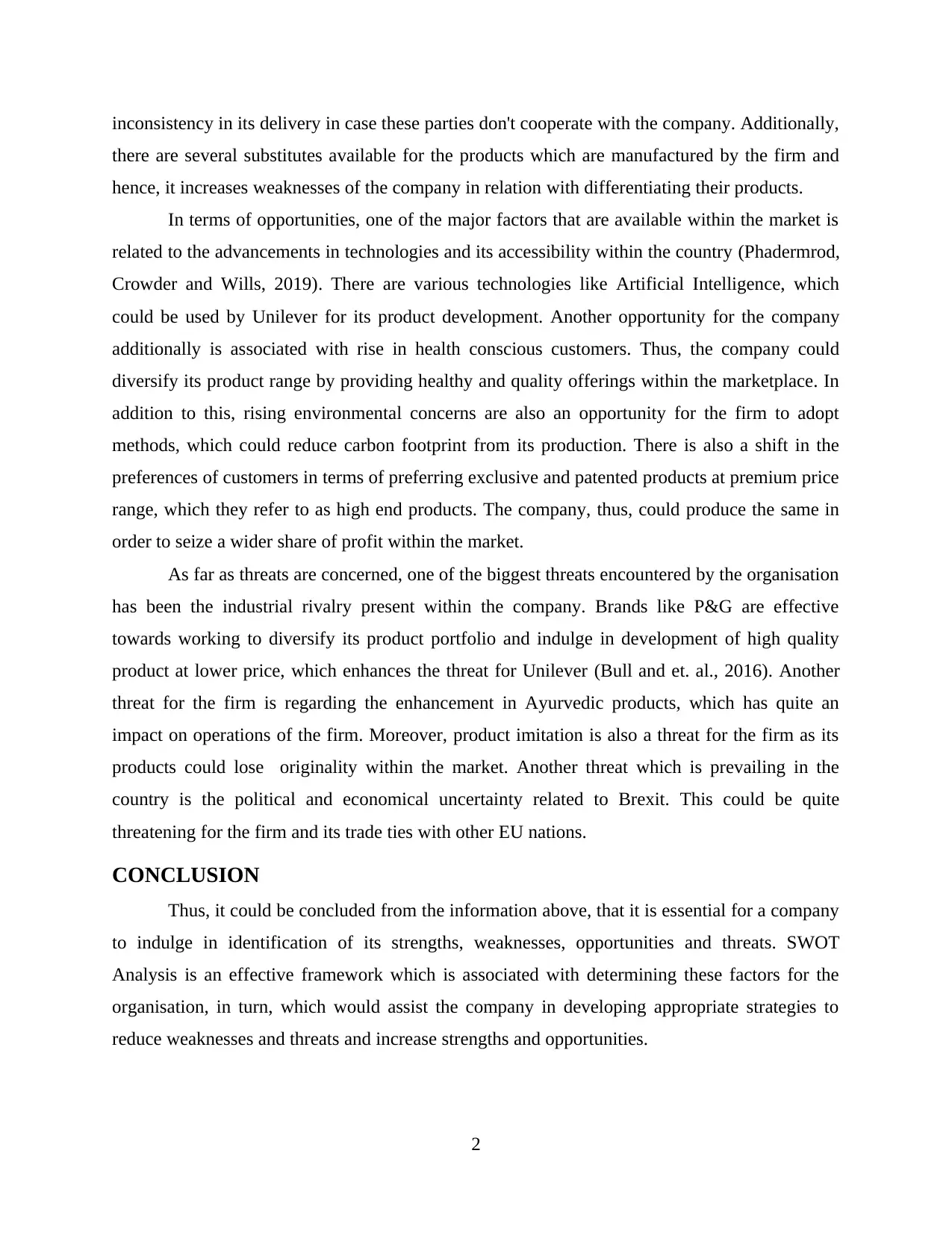
inconsistency in its delivery in case these parties don't cooperate with the company. Additionally,
there are several substitutes available for the products which are manufactured by the firm and
hence, it increases weaknesses of the company in relation with differentiating their products.
In terms of opportunities, one of the major factors that are available within the market is
related to the advancements in technologies and its accessibility within the country (Phadermrod,
Crowder and Wills, 2019). There are various technologies like Artificial Intelligence, which
could be used by Unilever for its product development. Another opportunity for the company
additionally is associated with rise in health conscious customers. Thus, the company could
diversify its product range by providing healthy and quality offerings within the marketplace. In
addition to this, rising environmental concerns are also an opportunity for the firm to adopt
methods, which could reduce carbon footprint from its production. There is also a shift in the
preferences of customers in terms of preferring exclusive and patented products at premium price
range, which they refer to as high end products. The company, thus, could produce the same in
order to seize a wider share of profit within the market.
As far as threats are concerned, one of the biggest threats encountered by the organisation
has been the industrial rivalry present within the company. Brands like P&G are effective
towards working to diversify its product portfolio and indulge in development of high quality
product at lower price, which enhances the threat for Unilever (Bull and et. al., 2016). Another
threat for the firm is regarding the enhancement in Ayurvedic products, which has quite an
impact on operations of the firm. Moreover, product imitation is also a threat for the firm as its
products could lose originality within the market. Another threat which is prevailing in the
country is the political and economical uncertainty related to Brexit. This could be quite
threatening for the firm and its trade ties with other EU nations.
CONCLUSION
Thus, it could be concluded from the information above, that it is essential for a company
to indulge in identification of its strengths, weaknesses, opportunities and threats. SWOT
Analysis is an effective framework which is associated with determining these factors for the
organisation, in turn, which would assist the company in developing appropriate strategies to
reduce weaknesses and threats and increase strengths and opportunities.
2
there are several substitutes available for the products which are manufactured by the firm and
hence, it increases weaknesses of the company in relation with differentiating their products.
In terms of opportunities, one of the major factors that are available within the market is
related to the advancements in technologies and its accessibility within the country (Phadermrod,
Crowder and Wills, 2019). There are various technologies like Artificial Intelligence, which
could be used by Unilever for its product development. Another opportunity for the company
additionally is associated with rise in health conscious customers. Thus, the company could
diversify its product range by providing healthy and quality offerings within the marketplace. In
addition to this, rising environmental concerns are also an opportunity for the firm to adopt
methods, which could reduce carbon footprint from its production. There is also a shift in the
preferences of customers in terms of preferring exclusive and patented products at premium price
range, which they refer to as high end products. The company, thus, could produce the same in
order to seize a wider share of profit within the market.
As far as threats are concerned, one of the biggest threats encountered by the organisation
has been the industrial rivalry present within the company. Brands like P&G are effective
towards working to diversify its product portfolio and indulge in development of high quality
product at lower price, which enhances the threat for Unilever (Bull and et. al., 2016). Another
threat for the firm is regarding the enhancement in Ayurvedic products, which has quite an
impact on operations of the firm. Moreover, product imitation is also a threat for the firm as its
products could lose originality within the market. Another threat which is prevailing in the
country is the political and economical uncertainty related to Brexit. This could be quite
threatening for the firm and its trade ties with other EU nations.
CONCLUSION
Thus, it could be concluded from the information above, that it is essential for a company
to indulge in identification of its strengths, weaknesses, opportunities and threats. SWOT
Analysis is an effective framework which is associated with determining these factors for the
organisation, in turn, which would assist the company in developing appropriate strategies to
reduce weaknesses and threats and increase strengths and opportunities.
2
Paraphrase This Document
Need a fresh take? Get an instant paraphrase of this document with our AI Paraphraser
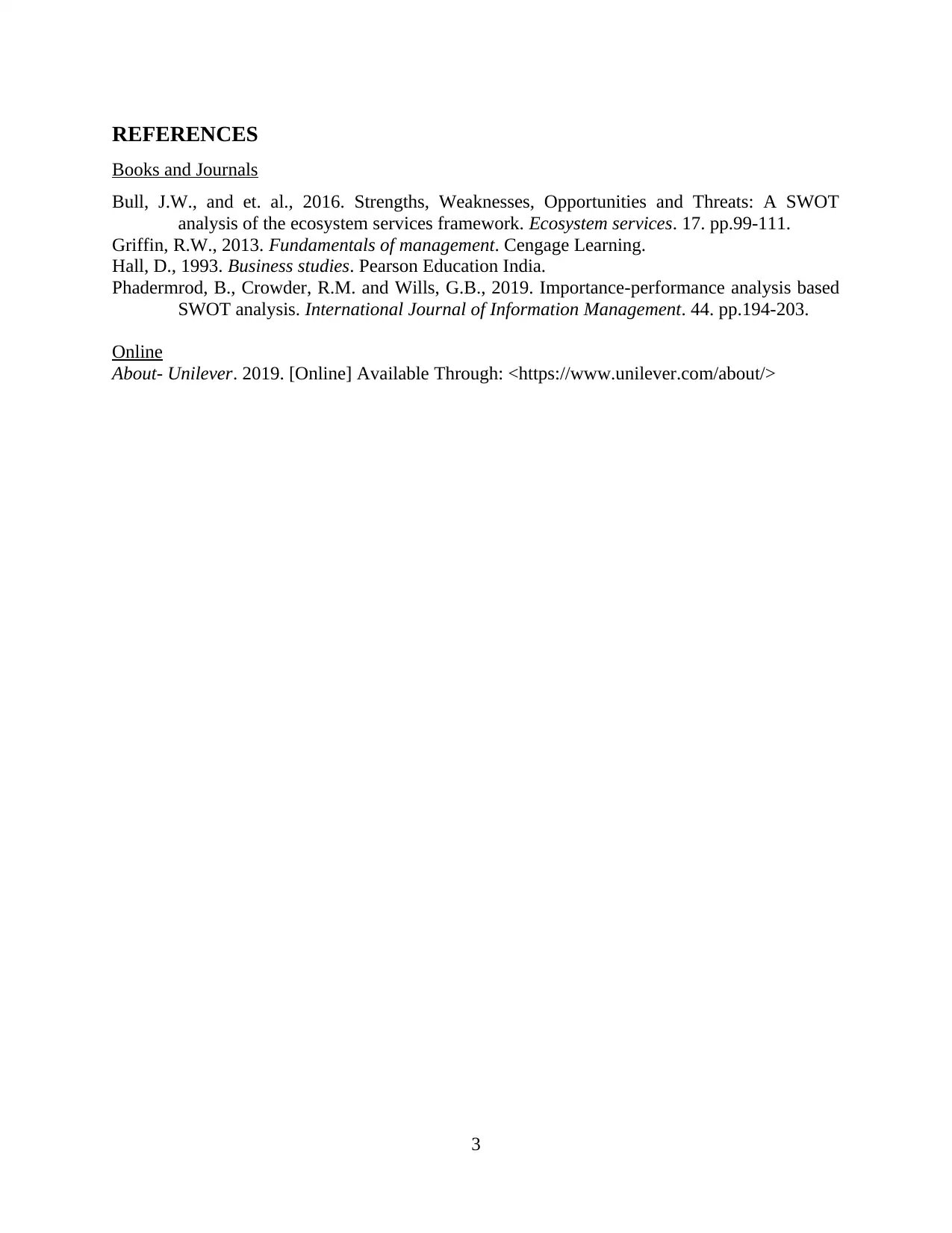
REFERENCES
Books and Journals
Bull, J.W., and et. al., 2016. Strengths, Weaknesses, Opportunities and Threats: A SWOT
analysis of the ecosystem services framework. Ecosystem services. 17. pp.99-111.
Griffin, R.W., 2013. Fundamentals of management. Cengage Learning.
Hall, D., 1993. Business studies. Pearson Education India.
Phadermrod, B., Crowder, R.M. and Wills, G.B., 2019. Importance-performance analysis based
SWOT analysis. International Journal of Information Management. 44. pp.194-203.
Online
About- Unilever. 2019. [Online] Available Through: <https://www.unilever.com/about/>
3
Books and Journals
Bull, J.W., and et. al., 2016. Strengths, Weaknesses, Opportunities and Threats: A SWOT
analysis of the ecosystem services framework. Ecosystem services. 17. pp.99-111.
Griffin, R.W., 2013. Fundamentals of management. Cengage Learning.
Hall, D., 1993. Business studies. Pearson Education India.
Phadermrod, B., Crowder, R.M. and Wills, G.B., 2019. Importance-performance analysis based
SWOT analysis. International Journal of Information Management. 44. pp.194-203.
Online
About- Unilever. 2019. [Online] Available Through: <https://www.unilever.com/about/>
3
1 out of 5
Related Documents
Your All-in-One AI-Powered Toolkit for Academic Success.
+13062052269
info@desklib.com
Available 24*7 on WhatsApp / Email
![[object Object]](/_next/static/media/star-bottom.7253800d.svg)
Unlock your academic potential
Copyright © 2020–2025 A2Z Services. All Rights Reserved. Developed and managed by ZUCOL.



